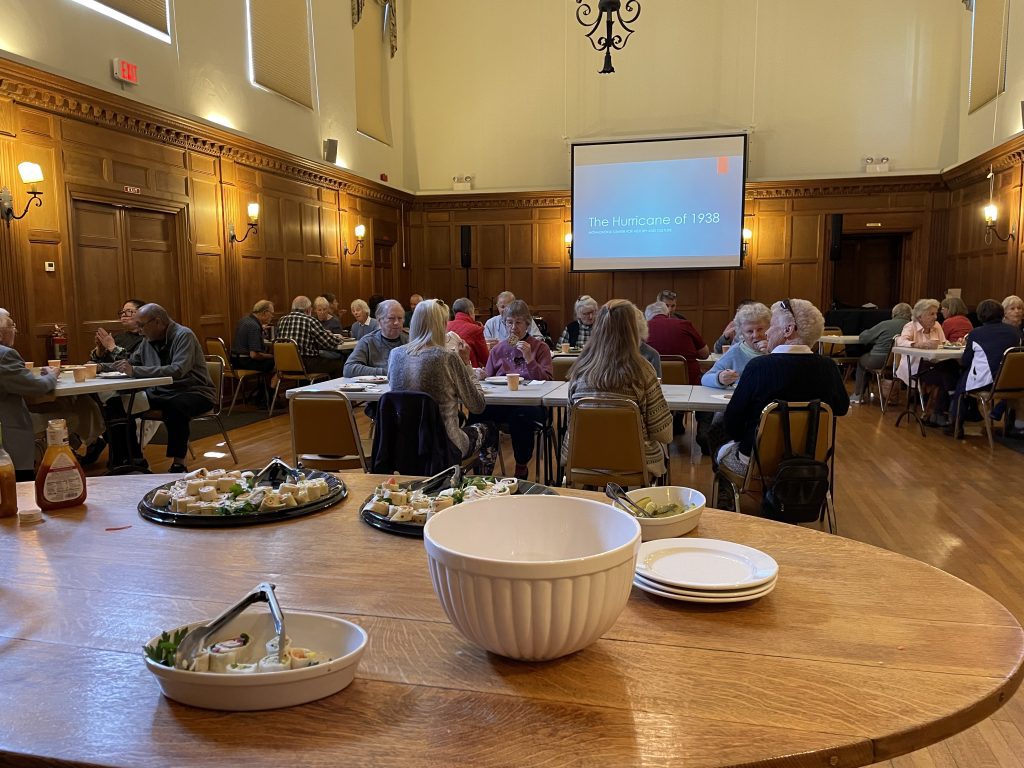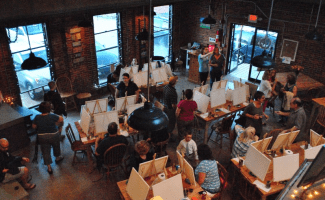NICOLE S. COLSON
The first on the list of core values at downtown Peterborough’s museum is that it welcomes everyone.
“People should leave feeling they were taken care of,” said Michelle Stahl, executive director of The Monadnock Center for History and Culture (formerly the Peterborough Historical Society).
A community museum and cultural center, the Center—open year-round—presents 60-plus programs, events and exhibits each year that celebrate the history and culture of Monadnock Region.
The Monadnock Center provides community space
Within the Center is Bass Hall, an assembly space (with a full kitchen) for hosting concerts, art shows, presentations, meetings, parties and other events. The hall is available for rental to individuals, businesses and organizations that offer discounts for members. Among the area organizations that host performances are Peterborough Folk Music Society and Electric Earth concerts.
“It was built to be a place for the community,” said Stahl. “It’s one of the most beautiful, intimate concert spaces. It has incredible acoustics and there’s a 1927 Steinway piano.”

Taking in an exhibit at the Center is also an intimate experience, Stahl went on, because it’s not a large, crowded museum.
“It gets busy during exhibits but it’s not like you can’t spend time with a work and not have people backing up behind you,” she said.
During gallery talks, Stahl will offer visitors a guided tour of the current exhibit. Normally, however, people will drop in and have a self-guided experience. Research on historic properties and events at the museum is by appointment.
“We’re here to answer questions,” she said.
The Center also offers walking tours of the area.
“Those are cultural experiences I take pride in,” said Stahl, “that everyone should be made to feel welcome here.”
The Center welcomes all abilities and backgrounds
Museum staff create an accessible and welcoming environment by literally embedding it into the Center’s mission and values.
“By saying we’re welcoming, we make those values guide the choices we make,” said Stahl.
The Center’s programming, from exhibits to concerts, is also physically accessible to all.
“All of our (exhibit) labeling is in large print for those with low vision,” said Stahl, “and when we have a talk that involves Powerpoint we make a printout and give it to guests who want it.”

All speakers at the museum use a microphone for those hard of hearing. Likewise, the Center provides an adequate turning radius for a wheelchair. Handicapped-accessible entrances and bathrooms are available.
By representing multiple cultural histories is yet another way the Monadnock Center welcomes all through its doors.
“We’re always looking at ways we can tell lesser-known stories,” said Stahl, who cited a multi-year research project to highlight the region’s black history she continues to work on in collaboration with the Historical Society of Cheshire County.
“Telling full stories of the region’s history is part of being fully welcoming,” said Stahl. “by telling everyone’s story—not just the elite story. When people see themselves represented—that’s a feeling of belonging and this is the place for them. That’s what we want.”
Community collaboration expands the Center’s outreach
Collaboration with other organizations is a practice the Center employs to build audiences.
“It brings in people from different perspectives,” said Stahl. Among those with which they have worked are MAXT Makerspace, Monadnock Art, the Peterborough town library and the Pastel Society of New Hampshire. A monthly partnership with MacDowell Downtown led to a recent series of free public presentations at the museum. The MacDowell Colony Fellows featured a wide array of programming, including film screenings, workshops, readings, writing seminars, art exhibitions, performances and talks.

One recent collaboration with the Hopkinton Historical Society produced an exhibit in Bass Hall this summer. The event focused on the indigenous people of the region: the Abenaki.
Including low-cost and free programming is always a focus at the Monadnock Center.
“Keeping admission and ticket prices as low as possible is something we’ve always done.” Admission to the museum is $5 and free for children 12 and under.
The Monadnock Center looks to a younger generation
Stahl considers young people to be a demographic with whom the organization wants to work on building a relationship.
“We offer family-oriented programs like our recent fairy house day; we’ve done free hearth cooking demonstrations,” she said, adding that the Center has 2,000 Facebook followers and an Instagram account. The museum also sends out a monthly e-newsletter and a bi-monthly program guide is available via the website.

Certain exhibits—like one the museum hosted featuring emerging artists—brought in young people, who in turn brought their friends.
“I think a lot about how to get them here,” said Stahl.
Organizations like the Monadnock Center for History and Culture, she went on, create a shared experience like none other.
“You see people at these programs that may be nothing like you but you’re all there because you have a shared interest,” she said. “It creates community amongst people. Even if you don’t talk to anyone else, being in a real place looking at a painting, or hearing music, or listening to an author—the reason you want to do it is because there’s nothing like the real thing. I think that’s what’s important.”
For more information about The Monadnock Center for History and Culture, visit www.monadnockcenter.org
For more information about the Arts Access Project: opening doors to the arts, visit Arts Access project and resources.




